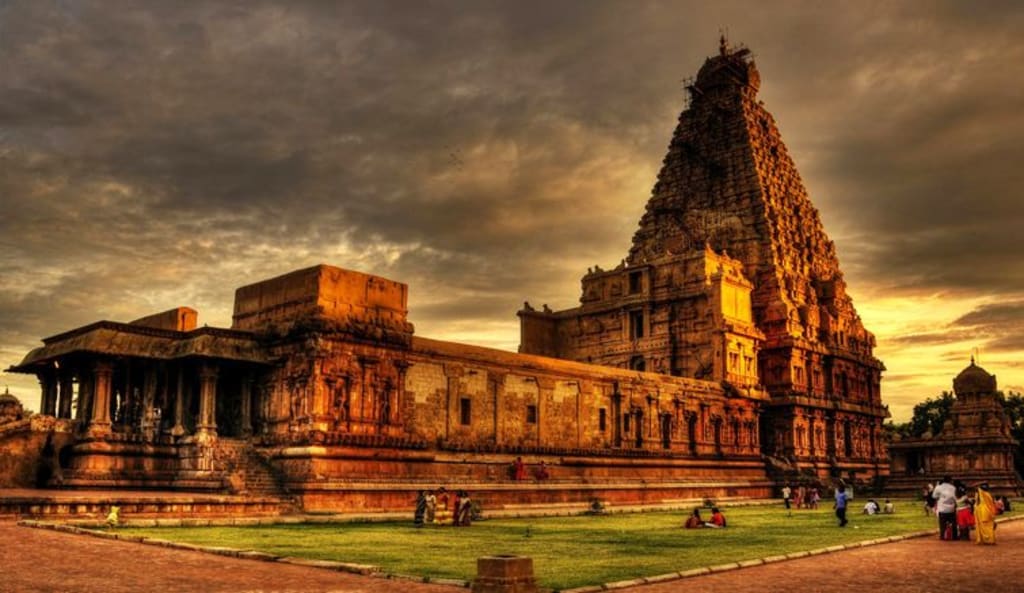
Thanjavur Brihadeeswara Temple, also known as Thanjavur Periya Kovil, is a UNESCO World Heritage site and one of the most famous temples in India. The temple was built by the Chola king Raja Raja I in the 11th century CE and is dedicated to Lord Shiva. Here's a brief history of the temple:
Construction:
The construction of the temple was started in 1003 CE and completed in 1010 CE during the reign of Raja Raja Chola. The temple was built to showcase the grandeur and power of the Chola dynasty. The construction of the temple was supervised by the famous architect Kunjara Mallan Raja Raja Perunthachan. It is said that over 130,000 tons of granite was used in the construction of the temple.
Architecture:
The Brihadeeswara temple is an architectural marvel and is considered a masterpiece of the Chola architecture. The temple is known for its grandeur, intricate carvings, and massive size. The temple is built on a raised platform and has a height of 66 meters. The vimana or tower above the sanctum sanctorum is one of the tallest in India and is made up of 13 storeys.
The temple has a huge Nandi statue, which is carved out of a single stone and weighs around 25 tonnes. The statue is 3.7 meters high and 6 meters long. The temple also has a 6.7-meter-high bronze statue of Lord Shiva in the form of Nataraja, the cosmic dancer.
Restoration:
Over the years, the temple suffered damages due to various reasons like natural calamities and invasions. The temple was renovated during the reign of the Nayak kings in the 16th century. The renovation work was carried out under the supervision of the chief architect of the Nayak dynasty, Krishnadevaraya. In 1997, the temple was declared a UNESCO World Heritage site, and since then, it has undergone several restoration works to preserve its heritage.
Today, Thanjavur Periya Kovil is one of the most visited temples in India and is a popular destination for tourists and pilgrims. The temple is an important cultural and historical monument and is an embodiment of the architectural and artistic skills of the Chola dynasty.
The Brihadeeswara Temple has played a significant role in the religious and cultural history of South India. It was the focal point of the Chola capital city of Thanjavur and was a symbol of the power and wealth of the Chola dynasty. The temple also played an important role in promoting the Shaivism sect of Hinduism.
The temple has several mandapams or halls, each with its own unique architecture and carvings. The Mahamandapam or the main hall has a massive granite roof supported by 12 pillars, each carved with intricate designs. The hall also has several sculptures and carvings depicting various episodes from Hindu mythology.
The temple complex also has several smaller shrines dedicated to various deities. The temple tank, known as the Shivaganga Tank, is located to the north of the temple and is considered holy by devotees.
The Brihadeeswara Temple has been a center of scholarship and learning. The temple complex has several inscriptions, some of which are in Sanskrit, Tamil, and Grantha scripts. These inscriptions provide valuable insights into the history, culture, and society of the Chola dynasty.
In conclusion, the Thanjavur Brihadeeswara Temple is a magnificent temple that stands as a testament to the artistic and architectural brilliance of the Chola dynasty. The temple is not just a religious site but also an important cultural and historical monument that attracts visitors from all over the world.
The temple has undergone several renovations over the centuries to preserve its heritage. In recent times, the Archaeological Survey of India has undertaken several restoration works to ensure the temple's longevity.
The temple's annual festival, the Mahamaham festival, is a grand celebration that takes place once every 12 years. The festival attracts lakhs of devotees from all over the country who come to take a holy dip in the Shivaganga Tank and seek the blessings of Lord Shiva.
The temple's importance in the cultural and religious history of South India has earned it a place on the UNESCO World Heritage site list. The site is recognized as a masterpiece of Chola architecture and a testament to the achievements of the Tamil civilization.
The Brihadeeswara Temple stands as a symbol of the rich cultural and artistic heritage of India. Its intricate carvings, grand architecture, and religious significance have made it an icon of the country's spiritual and artistic traditions.
Some interesting facts about Thanjavur Periya Kovil are:
- The temple was built entirely without using any binding materials like cement or mortar.
- The shadow of the temple's vimana never falls on the ground during the noon hours, which is an architectural marvel.
- The temple's gopuram or entrance tower is one of the largest in South India and has several intricate carvings and sculptures.
- The temple's main deity, Lord Shiva, is called Brihadeeswara, which means the "great lord."
- The temple's Nandi statue, which is carved out of a single stone, is believed to be the second-largest Nandi statue in India.
- The temple's construction involved the contribution of artists and craftsmen from all over the Chola kingdom, showcasing the unity and diversity of the region.
- The temple's inscriptions provide valuable information about the social, economic, and cultural life of the Chola dynasty.
- The temple's annual festival, the Mahamaham festival, is considered one of the largest Hindu festivals in South India and attracts lakhs of devotees.
The Thanjavur Periya Kovil remains an architectural wonder that attracts visitors and pilgrims from all over the world. The temple's grandeur and religious significance have earned it a special place in the hearts of devotees and scholars alike.
Apart from its architectural and cultural significance, the Thanjavur Periya Kovil has also played a crucial role in the socio-economic history of the Chola dynasty. The temple was not only a religious center but also a hub of economic activity. The temple complex had several industries like metalwork, pottery, weaving, and sculpture, providing employment opportunities for the local population.
The temple was also a center of education and learning, with several scholars and artists patronized by the Chola kings. The temple's inscriptions provide valuable information about the literary and cultural achievements of the Chola dynasty, and many literary works like the Tirukkural and the Manimekalai were composed during this period.
Today, the temple remains an important pilgrimage site for devotees of Lord Shiva and a cultural heritage site attracting tourists from all over the world. The temple's grandeur and magnificence continue to inspire awe and wonder, and its significance in the history and culture of South India remains unparalleled.
In conclusion, the Thanjavur Periya Kovil, also known as the Brihadeeswara Temple, is a masterpiece of South Indian architecture, religious and cultural heritage, and an icon of the Chola dynasty's achievements. Its intricate carvings, grand architecture, and historical significance continue to fascinate and inspire generations, making it one of the most significant and enduring cultural monuments in India.
Visitors to the Thanjavur Periya Kovil can experience the rich heritage of the temple complex through various activities. The temple complex has several smaller shrines and mandapams or halls, each with its unique architectural and artistic features. Visitors can explore these structures and marvel at their intricate carvings and sculptures.
The temple complex also has several ponds and tanks, including the Shivaganga Tank, where the Mahamaham festival is held. Visitors can take a dip in these tanks and seek the blessings of Lord Shiva.
The temple complex also has several bazaars selling traditional handicrafts and souvenirs, providing visitors with a glimpse into the local culture and craftsmanship.
The Thanjavur Periya Kovil is not only a religious and cultural monument but also a symbol of the enduring legacy of the Chola dynasty and its contributions to South Indian history and culture. Its significance in the global cultural heritage landscape makes it a must-visit destination for anyone interested in history, architecture, and culture.
In conclusion, the Thanjavur Periya Kovil, with its grandeur, magnificence, and historical significance, remains an iconic cultural monument in India. Its preservation and promotion are crucial in ensuring the sustainable development and promotion of India's rich cultural and artistic heritage.






Comments
There are no comments for this story
Be the first to respond and start the conversation.